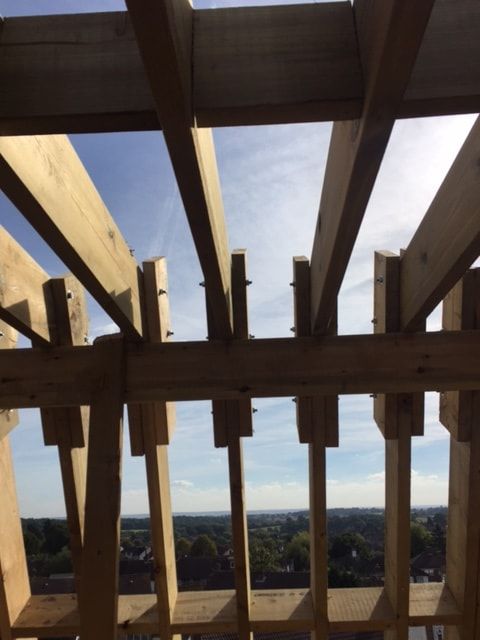Party Wall Agreements for Loft Conversions, a Detailed Guide

Do I need a party wall agreement for a loft conversion?
The need for a party wall agreement often applies to loft conversions and to other types of extensions. If your loft has an adjoining properties, you must have a party wall agreement in place with your neighbours, according to the Party Wall Act 1996. The act always applies if you need to work on a shared wall or other shared structures.
This is very often the case for loft conversions and other extensions, because the party walls are usually the best option as load bearing walls. The reason is that party wall don’t have openings like windows or doors, so they make for the most solid choice for a load bearing wall.
Party wall agreements must be in place with all the leaseholders and the freeholder of the adjoining properties.
How to find a party wall surveyor
You can find a party wall surveyor from the pages of the Faculty of party wall surveyors.
What is a party wall?
A wall is a party wall if it stands astride the boundary of land belonging to two (or more) different owners. This definition often applies to adjoining houses like terraced or semi-detached houses. A wall is also considered a party wall if it is shared with other owners, as in the case of ceiling and floor of two properties, one below the other.
As a general rule, a wall is a party wall whenever a damage to that wall, or structure in general, could damage other owners’ properties. For example, when excavation is required, the party wall can apply to properties that are up to a 6m distance from the place of excavation.
What is the Party Wall Act 1996?
The Party Wall Act etc 1996 provides a Building Owner, who wishes to carry out various sorts of work to an existing party wall, with additional rights going beyond ordinary common law rights.
All the details on party walls and if and when you need a party wall agreement can be found in the Party Wall etc. Act 1996. It is meant to prevent and resolve disputes between neighbours when works on adjoining properties are carried out by the owners.
The Party Wall Act regulates the legal process to inform the affected parties about planned building works that affect shared structures, the timing, the form and the rights and duties of each party involved.
Under the Party Wall Act, building owners who intends to carry out building works involving existing party walls have to inform the adjoining owners about the work. A party wall agreement is the consent to the works given by the parties involved.
What is a party wall agreement?
The party wall agreement is a written consent by neighbours on the building works you intend to carry out. Adjustments in the timing and manner of the works might be requested by the neighbours to reach the agreement.
The Party Wall Act prescribes that you inform your neighbours of the works you intend to carry out. This is done serving a party wall notice, that must include:
- your own name and address
- the address of the building to be worked on
- a full description of what you propose to do, that might use plans and drawings
- when you propose to start
You can produce and serve this document or you can use a party wall surveyor to represent you. Your neighbours can also appoint a surveyor. In general, you will need to meet all the costs for surveyors, including your neighbours’.
For loft conversions, the notice must be served at least 2 months before the planned start of the works.
Do I need a party wall agreement for a loft conversion?
When planning a loft conversion, you will need a party wall agreement if you are going to work on any element that belongs to one or more adjoining properties.
Examples of work on a party wall for a loft conversion that will require a party wall agreement:
- Cut the wall and use it as a load bearing wall for a beam
- Insert a damp course proof for the whole length of the wall
- Demolish and rebuild part of the wall
- Increase the thickness or the height of the wall
- Cut projections off the party wall
- Remove a chimney breast from a party wall
- Underpin the whole thickness of the party wall
Can I do a loft conversion without a party wall agreement?
It is possible that you won’t need a party wall agreement for a loft conversion. In general, you won’t need it if the works are not going to involve a wall that is shared with an adjoining property.
An agreement is not needed if:
- The loft is being built on top of a stand alone or detached house
- The beam to support the loft conversion is placed over a column built for the purpose, instead of placing it inside the party wall
In the latter case, the beam is placed on two opposing walls that are not party walls. We used this solution for one of our projects, where the party wall process was particularly complicated.
Issuing a party wall notice
As mentioned, you can create and serve the party wall notice yourself. You will need to include:
- your own name and address
- the address of the building to be worked on
- a full description of what you propose to do, that might use plans and drawings
- when you propose to start
It is advisable you clearly state that the letter is a party wall notice.
You may deliver the notice in person, send it by post, or send it by email. If you do not have the details of the owner, you can deliver it to the property and address it to The owner of the property at that address.
Party wall agreement template
Templates of party wall notices are available for free from many sources online. You can download our Party wall notice for loft conversions template.
To make the process smoother, it includes the positive acknowledgment response, to be sent together with the notice.
How long in advance do I need to serve the notice?
The term to serve the notice is at least two months before the starting date. The notice is only valid for a year, so it’s better to serve it not too long before you wish to start.
What happens after I serve the notice?
Your neighbours have several options after they receive your party wall notice:
- give consent in writing
- refuse to consent to the works proposed
- do nothing
If nothing happens after 14 days or your neighbour refuses, it is considered as a dispute happening and a party wall award is required and surveyors need to be appointed.
Approval
If your neighbour gives consent in writing, you can proceed with your planned works. It is advisable to assess the current status of the party wall on your neighbours’ side, taking pictures as evidence. This helps in case disputes arise later, after the works have started.
You can do this yourself or appoint a surveyor to do so.
It is possible that your neighbours appoint a surveyor to assess the existing status.
Refusal
If your neighbour dissents or doesn’t reply in 14 days, you will need to appoint a surveyor to draw up a Party Wall Award.
The best option is to have an Agreed Surveyor. Alternatively, you will appoint a surveyor each. The two appointed surveyors will select a third surveyor, who would be called in only if the two appointed surveyors cannot agree or either of the owners or either surveyor calls upon the third surveyor to make an award.
In all cases, the surveyors have the duty to resolve matters in a fair and practical way.
How to find a party wall surveyor
You can find a party wall surveyor from the pages of the Faculty of party wall surveyors.
Loft conversion with houseUP
In houseUP we can help to make your loft conversion process easier. Our experience covers all types of loft conversions in London.
Contact us for free advice on how to sort out issues with party wall agreements and loft conversions in London.
Gen is managing director and chief of digital strategy at houseUP. She has a background in information security and product management in tech startups.
houseUP is a construction company in London, specialised in high end residential and commercial projects.

